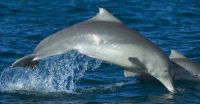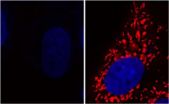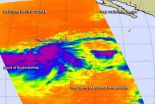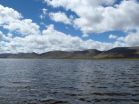(Press-News.org) Scientists examining a taxonomically confused group of marine mammals have officially named a species new to science: the Australian humpback dolphin, Sousa sahulensis, according to the Wildlife Conservation Society and Clymene Enterprises.
The study describing the newly named species is the culmination of a 17-year long systematic examination of all available historical records, physical descriptions, and genetic data of humpback dolphins—a widespread group of coastal cetaceans ranging from the coast of West Africa to the northern coast of Australia. The Australian humpback dolphin becomes the fourth recognized humpback dolphin species.
The study appears online today in the journal Marine Mammal Science, and will appear in the journal's October edition. The authors are: Thomas A. Jefferson of Clymene Enterprises and Howard C. Rosenbaum of the Wildlife Conservation Society.
"We've finally managed to settle many long-standing questions about humpback dolphins—particularly how many species actually exist—using a huge body of data collected over two centuries and analyzed with the latest scientific tools," said Dr. Jefferson.
"The formal recognition and naming of a new species brings with it a need to formulate or update plans for protection of these dolphins," said Dr. Rosenbaum, Director of WCS's Ocean Giants Program. "Humpback dolphins throughout their range are threatened with fisheries interactions, vessel impacts, and development in their coastal habitats. Efforts to protect humpback dolphins and other coastal dolphins, and their most important habitats are essential for the survival of these species."
The process of describing a species new to science requires a systematic analysis of all species most closely related to the animal in question. The humpback dolphins in particular have vexed researchers and taxonomists for decades until researchers from the Wildlife Conservation Society and a number of other institutions provided the most definitive results in late 2013.
Noteworthy naturalists such as Richard Owen (who coined the word "dinosaur"), Georges Cuvier, and Richard Lydekker have added to the literature on humpback dolphins over the centuries. In recent years, scientists have disagreed with one another about the number of species, with some considering all humpback dolphins the same species and others postulating as many as nine different ones.
The new study contains detailed reviews and descriptions of the currently recognized four humpback dolphin species, using external and skeletal measurements, coloration, molecular genetics, and geographic distribution. The study is the next step building upon recent studies that first detected the existence of a unique humpback dolphin species inhabiting the waters of northern Australia and the island of New Guinea, using genetics and morphological characters.
The Australian humpback dolphin species joins the current assemblage of three other closely related species: the Atlantic humpback dolphin (Sousa teuszii), the Indo-Pacific humpback dolphin (Sousa chinensis), and the Indian Ocean humpback dolphin (Sousa plumbea). The new dolphin's scientific name—Sousa sahulensis—is derived from the Sahul Shelf, an underwater shelf stretching between northern Australia and southern New Guinea, where the Australian humpback dolphin occurs.
Aside from slight differences in overall length, number of teeth and vertebrae, and geographic distribution, the Australian humpback dolphin differs in appearance from the other three humpback species. Its dorsal fin is lower and more wide-based than the dorsal fins of Sousa teuszii and S. plumbea, and its coloration is dark gray, as opposed to the distinctly white (often with a pink tinge) coloration of its closest humpback neighbor, Sousa chinensis. The Australian humpback dolphin also possesses a distinctive dark dorsal "cape."
Another interesting finding with the designation of the Australian humpback dolphin is the support its distribution provides to a zoogeographical barrier described by Alfred Russell Wallace, one of the first naturalists to examine in detail the life of the Malay Archipelago. He identified a barrier now known as the Wallace Line. To the west of the line, terrestrial animal species are mostly of Asian origin; to the east, animal species largely descend from Australasian ancestors. Researchers have also found the Wallace Line to be a barrier for marine species as well, and the divide between Indo-Pacific and the Australian humpback dolphins seems to coincide with this border.
There is currently no population estimate for the Australian humpback dolphin, but the authors warn that it is unlikely that more than a few thousand dolphins of that species exist, based on available sighting data. Potential threats to all humpback dolphins include coastal development, accidental capture by fishermen, vessel collisions, and in a few cases direct hunting.
INFORMATION:
http://onlinelibrary.wiley.com/doi/10.1111/mms.12152/abstract END
Scientists name new species of cetacean: The Australian humpback dolphin
Study of dolphin group produces taxonomic clarity and a new member
2014-08-01
ELSE PRESS RELEASES FROM THIS DATE:
Electronic reminders can help patients prevent surgical site infections
2014-08-01
CHICAGO (August 1, 2014)—The use of electronic reminders such as text messages, emails or voicemails is highly effective at getting surgical patients to adhere to a preadmission antiseptic showering regimen known to help reduce risk of surgical site infections (SSIs), according to a first-of-its-kind study published in the August issue of the Journal of the American College of Surgeons.
Each year approximately 400,000 SSIs occur and lead to a death rate approaching nearly 100,000 according to data sources cited by study authors. To help reduce the risk of these dangerous ...
Potential treatment and prevention of Parkinson's disease
2014-08-01
This news release is available in German.
Parkinson's disease affects neurons in the Substantia nigra brain region – their mitochondrial activity ceases and the cells die. Researchers at the Max Planck Institute of Molecular Cell Biology and Genetics show that supplying D-lactate or glycolate, two products of the gene DJ-1, can stop and even counteract this process: Adding the substances to cultured HeLa cells and to cells of the nematode C. elegans restored the activity of mitochondria and prevented the degeneration of neurons. They also showed that the two substances ...
NASA eyes powerful bands of thunderstorms in newborn Tropical Storm Iselle
2014-08-01
Tropical Storm Iselle was born in the Eastern Pacific Ocean soon after NASA's Aqua satellite gathered infrared imagery on the storm that showed powerful thunderstorms wrapping into developing storm's center. Iselle is not close enough to land to cause any watches or warnings.
The Atmospheric Infrared Sounder or AIRS instrument aboard NASA's Aqua satellite passed over System 95E on July 31 at 5:23 p.m. EDT from gathered infrared data before it became Tropical Storm Iselle. The data was made into a false-colored image at NASA's Jet Propulsion Laboratory in Pasadena, California. ...
Heavy metals and hydroelectricity
2014-08-01
Boulder, Colorado, USA – Hydraulic engineering is increasingly relied on for hydroelectricity generation. However, redirecting stream flow can yield unintended consequences. In the August 2014 issue of GSA Today, Donald Rodbell of Union College-Schenectady and coauthors from the U.S. and Peru document the wholesale contamination of the Lake Junín National Reserve by acid mine drainage from the Cerro de Pasco mining district.
According to the World Bank, about 60% of Peru's electricity is generated by hydropower, which during the dry season relies heavily on glacial meltwater ...
Scripps Research Institute scientists find new calorie-burning switch in brown fat
2014-08-01
LA JOLLA, CA—August 1, 2014—Biologists at The Scripps Research Institute (TSRI) have identified a signaling pathway that switches on a powerful calorie-burning process in brown fat cells.
The study, which is reported in this week's online Early Edition of the Proceedings of the National Academy of Sciences, sheds light on a process known as "brown fat thermogenesis," which is of great interest to medical researchers because it naturally stimulates weight loss and may also protect against diabetes.
"This finding offers new possibilities for the therapeutic activation ...
New mothers still excessively sleepy after 4 months: QUT study
2014-08-01
New mums are being urged to be cautious about returning to work too quickly, after a QUT study found one in two were still excessively sleepy four months after giving birth.
Dr Ashleigh Filtness, from QUT's Centre for Accident Research & Road Safety - Queensland (CARRS-Q), studied the sleep patterns and tiredness of postpartum mums and found despite new mums recording stable night sleep times at 18 weeks, they continued to report being excessively tired.
The CARRS-Q study, published in PLOS ONE, followed 33 healthy new mums who recorded their postpartum sleep patterns ...
Effect of microenvironment modulation on stem cell therapy for spinal cord injury pain
2014-08-01
Spinal cord injury (SCI) currently ranks second after mental retardation among neurological disorders in terms of cost to society. Pain is a debilitating consequence of SCI related to the nature of the lesion, neurological structures damaged, and secondary pathophysiological changes of surviving tissues1. Approximately two-thirds of persons who have sustained SCI experience clinically significant pain after injury, of whom one-third have severe pain2, 3. Post-SCI pain can increase with time and is often refractory to conventional treatment approaches4. Over the past decade, ...
Acrolein as a novel therapeutic target for motor and sensory deficits in spinal cord injury
2014-08-01
Acrolein, a highly reactive unsaturated aldehyde, has been shown to play a major role in the secondary injury by contributing significantly to both motor and sensory deficits. Prof. Riyi Shi, who comes from University of Purdue in USA will highlight the recent developments in the understanding of the mechanisms of acrolein in motor and sensory dysfunction in animal models of spinal cord injury, and will also discuss the therapeutic benefits of using acrolein scavengers to attenuate acrolein-mediated neuronal damage following spinal cord injury. The relevant study has been ...
Recent advances in stem cell biology
2014-08-01
Advances in stem cell research will provide enormous opportunities for both biological and future clinical applications. Basically, stem cells could replicate any other cells in the body, offering immense hope of curing Alzheimer's disease, repairing damaged spinal cords, treating kidney, liver and lung diseases and making damaged hearts whole. The potential for profit is staggering. Prof. Jinhui Chen from Indiana University in USA considered that this field of research still faces myriad biological, ethical, legal, political, and financial challenges. The eventual resolution ...
Developmental regulation of important plant phloem components discovered
2014-08-01
Sieve elements are a key component of phloem, the conductive tissue through which plants transport carbohydrates and a wide range of signalling molecules. Elongated cylindrical cells are capped at one end by a sieve plate and arranged end-to-end to form sieve tubes which in turn form a network throughout a plant's body.
"Sieve elements are very special cells which play an important role in carbon sequestration, yet so far very little has been known about their differentiation," says Professor Ykä Helariutta from the Institute of Biotechnology, University of Helsinki, ...
LAST 30 PRESS RELEASES:
Heart-brain connection: international study reveals the role of the vagus nerve in keeping the heart young
Researchers identify Rb1 as a predictive biomarker for a new therapeutic strategy in some breast cancers
Survey reveals ethical gaps slowing AI adoption in pediatric surgery
Stimulant ADHD medications work differently than thought
AI overestimates how smart people are, according to HSE economists
HSE researchers create genome-wide map of quadruplexes
Scientists boost cell "powerhouses" to burn more calories
Automatic label checking: The missing step in making reliable medical AI
Low daily alcohol intake linked to 50% heightened mouth cancer risk in India
American Meteorological Society announces Rick Spinrad as 2026 President-Elect
Biomass-based carbon capture spotlighted in newly released global climate webinar recording
Illuminating invisible nano pollutants: advanced bioimaging tracks the full journey of emerging nanoscale contaminants in living systems
How does age affect recovery from spinal cord injury?
Novel AI tool offers prognosis for patients with head and neck cancer
Fathers’ microplastic exposure tied to their children’s metabolic problems
Research validates laboratory model for studying high-grade serous ovarian cancer
SIR 2026 delivers transformative breakthroughs in minimally invasive medicine to improve patient care
Stem Cell Reports most downloaded papers of 2025 highlight the breadth and impact of stem cell research
Oxford-led study estimates NHS spends around 3% of its primary and secondary care budget on the health impacts of heat and cold in England
A researcher’s long quest leads to a smart composite breakthrough
Urban wild bees act as “microbial sensors” of city health.
New study finds where you live affects recovery after a hip fracture
Forecasting the impact of fully automated vehicle adoption on US road traffic injuries
Alcohol-related hospitalizations from 2016 to 2022
Semaglutide and hospitalizations in patients with obesity and established cardiovascular disease
Researchers ‘listen in’ to embryo-mother interactions during implantation using a culture system replicating the womb lining
How changing your diet could help save the world
How to make AI truly scalable and reliable for real-time traffic assignment?
Beyond fragmented markets: A new framework for efficient and stable ride-pooling
Can shape priors make road perception more reliable for autonomous driving?
[Press-News.org] Scientists name new species of cetacean: The Australian humpback dolphinStudy of dolphin group produces taxonomic clarity and a new member






